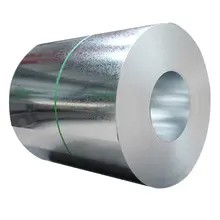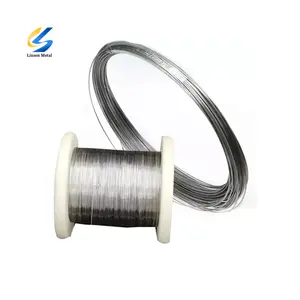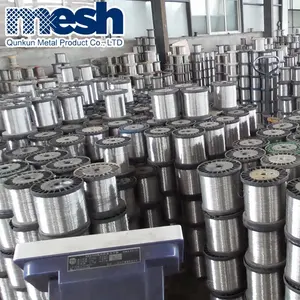Introduction
Stainless steel wire, a versatile and resilient material, has revolutionized modern architecture. Its inception in the early 20th century has led to its widespread use in various applications, from skyscrapers to kitchen cutlery. This article delves into the evolution of stainless steel wire, its properties, and its applications in modern architecture. We will also explore the challenges and solutions associated with its use, and the future trends that are shaping its role in the architectural landscape. The journey of stainless steel wire from its humble beginnings to its current prominence in architecture is a testament to human ingenuity and the relentless pursuit of innovation.
The Evolution of Stainless Steel Wire in Architecture
Stainless steel, a relatively new material, was invented about a century ago. Its birth can be traced back to 1913 when Harry Brearley of Sheffield, UK, discovered a 'rustless steel' while trying to solve a problem for the British army. He invented a genuinely stainless steel by mixing steel with other alloys, principally chromium due to its ability to prevent corrosion. Over the past century, roughly 100 different grades of stainless steel have been invented and made commercially available. Today, stainless steel is one of the most commonly used metals in the world, utilized for everything from skyscrapers to kitchen cutlery.
Properties of Stainless Steel Wire
Stainless steel wire, like other forms of stainless steel, is known for its corrosion resistance, primarily due to its minimum chromium content of 10.5%. This makes it approximately 200 times more resistant to corrosion than steels without chromium. It also boasts high strength and durability, resistance to high and low temperatures, and increased formability. It's easy to fabricate, requires low maintenance, and is long-lasting. Furthermore, stainless steel wire is environmentally friendly and recyclable, making it a sustainable choice for various applications.
Corrosion Resistance
Stainless steel wire ropes boast higher corrosion resistance to salt water than galvanized wire ropes, making them the best choice for marine applications. The bright appearance of galvanized wire ropes will dull over time, but stainless steel wire rope will maintain its bright and modern appearance for years.
Strength and Durability
Stainless steel wire rope is known for its exceptional strength and durability. For instance, Grades 301 and 304 stainless steel possess a tensile strength of up to 1300 MPa in strip and wire forms, making it remarkably strong compared to other materials. This strength contributes to its long lifespan, making it effective across a wide range of applications over many cycles. Even under extreme conditions, stainless steel can perform effectively, making it a strong alternative to more expensive materials.
Flexibility and Versatility
The flexibility and versatility of stainless steel wire rope are determined by its grade, diameter, and structure. For instance, the 1×19 Wire Rope, predominantly used in standing rigging and architectural structural rigging, doesn't allow for tight kinks or bends. The 7×7 Wire Rope, often used in rigging and balustrade infill, offers different characteristics. Lastly, the 7×19 Wire Rope, used where high flexibility is required, is more for architectural use than structural. Each type of wire rope serves different purposes, showcasing the versatility of stainless steel wire in various applications.
Applications of Stainless Steel Wire in Modern Architecture
Stainless steel wire has found diverse applications in modern architecture. For instance, in a prominent university building, over 1,500 cables made from 5mm wire rope were used to construct a barrier to the atrium, providing robust, non-climbable fall protection systems. The wire's unobtrusive and modern appearance, along with its durability and low maintenance, make it an ideal choice. Another application is seen in a 9-metre tall wind-responsive sculpture, where the wire's flexibility allows it to move with the wind while remaining strong.
Structural Applications
Stainless steel wire, particularly those containing nickel, is increasingly used in structural applications due to its strength, durability, and corrosion resistance. It's a popular choice in challenging environments, including industrial facilities and coastal areas. Its high ductility makes it ideal for seismic resistance. Applications range from beams, columns, and supports in various industries to fasteners and anchoring systems in wood, stone, masonry, or rock. It's also used in explosion and impact-resistant structures, demonstrating its versatility and robustness.
Decorative Applications
Stainless steel wire mesh is not only strong and workable but also aesthetically appealing, making it a perfect choice for architectural applications. Its shiny luster adds a touch of elegance to any project. Economical, versatile, and lightweight, stainless steel wire mesh can be used in a variety of decorative applications, enhancing the aesthetics of any architectural, industrial, or commercial project. Both interior and exterior applications can be catered to with different types of stainless steel.
Innovative Uses in Green Architecture
Stainless steel, including stainless steel wire, is a green material due to its 100% recyclability. Its production doesn't produce toxic run-off, contributing to environmental sustainability. In the realm of green architecture, stainless steel wire can be used in various applications, maintaining its value even after extensive use. Its high scrap value and recyclability ensure it's diverted from landfills and recaptured for use in new stainless steel products. The quality of recycled stainless steel remains the same as the original, making it an ideal material for sustainable architectural designs.
Challenges and Solutions in Using Stainless Steel Wire
One of the key challenges in using stainless steel wire is fatigue, which can lead to the wire ropes breaking. This fatigue is often caused by consistent bending and can be accelerated by abrasion, kinking, and nicking. The severity of fatigue varies depending on the materials, machine type, and application. It's crucial to understand these factors to effectively manage and mitigate the effects of fatigue on stainless steel wire.
Cost and Availability
Stainless steel wire ropes are available in a wide range of prices on Alibaba.com, depending on the length, and features. The price also varies based on the strand construction, with options like 1x19, 6x19, 7x19, and 7x7 available. The product length can range from 1 ft to 1000 ft, affecting the cost. Special values and special buys are also available on Alibaba.com, offering potential savings for buyers.
Installation and Maintenance
Stainless steel wire railings, due to their durability and weather resistance, require minimal maintenance. Installation is straightforward, making them a viable choice for both homeowners and professionals. High-grade stainless steel withstands various weather conditions, maintaining its appearance for decades without the need for stripping, sanding, staining, or painting. An annual gentle clean is usually sufficient, using a soft brush and mild dish soap to remove dirt or particles. However, in coastal locations, the salt air may necessitate more frequent cleaning. Any damage or corrosion should be addressed promptly with a manufacturer-recommended rust solution.
Future Trends in Stainless Steel Wire Use in Architecture
The role of stainless steel in building architecture is continuously evolving, with its alloyed metal offering ways to reduce carbon footprints and improve the skylight of tomorrow. Its flexibility allows it to shapeshift into any form a builder desires, making it a preferred choice for future architectural designs. Moreover, its ability to withstand harsh temperatures and easy maintenance make it a sustainable choice for the future of architecture.
Conclusion
Stainless steel wire has proven to be a game-changer in modern architecture, offering a blend of strength, durability, and aesthetic appeal. Its corrosion resistance, flexibility, and recyclability make it a sustainable choice for various applications, from structural to decorative. Despite challenges such as fatigue and cost, solutions are available to ensure its effective use. The future of stainless steel wire in architecture looks promising, with its role continuously evolving to meet the demands of sustainable and innovative design. As we move forward, stainless steel wire will continue to shape our built environment, reflecting our commitment to durability, aesthetics, and environmental sustainability.
































 浙公网安备 33010002000092号
浙公网安备 33010002000092号 浙B2-20120091-4
浙B2-20120091-4